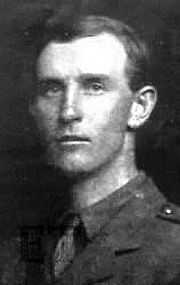Raymond Asquith
| Raymond Asquith | |
|---|---|
 | |
| Born | 6 November 1878 |
| Died |
15 September 1916 (aged 37) Near Ginchy, France |
Resting place | Guillemont Road Cemetery |
| Nationality | British |
| Education | Winchester College, Balliol College, Oxford |
| Occupation | Lawyer |
| Spouse(s) | Katharine Frances Horner |
| Children | Lady Helen Frances Asquith, Lady Perdita Rose Mary Asquith, Julian Asquith, 2nd Earl of Oxford and Asquith |
Raymond Asquith (6 November 1878 – 15 September 1916) was an English barrister and eldest son and heir of British Prime Minister H. H. Asquith by his first wife Helen Kelsall Melland (who died 1891).
Career and honours
Asquith was educated at Winchester College and won a scholarship to Balliol in 1896, bringing with him a reputation for brilliance. He won Ireland, Derby, and Craven scholarships, and was distinguished by first-class honours. Elected a fellow of All Souls in 1902, he was called to the bar in 1904.[1] The tall, handsome Asquith was a member of "the Coterie," a group of Edwardian socialites and intellectuals.
Asquith was junior counsel in the North Atlantic Fisheries Arbitration and the investigation of the sinking of the Titanic, and was considered a putative Liberal candidate for Derby. However, his rise was interrupted by the outbreak of World War I. He was initially commissioned, on 17 December 1914, as a second lieutenant in the 16th (County of London) Battalion, London Regiment.[2] He was transferred to the 3rd Battalion, Grenadier Guards, on 14 August 1915[3] and assigned as a staff officer, but he requested to be returned to active duty with his battalion, a request granted before the Battle of the Somme. While leading the first half of 4 Company in an attack near Ginchy on 15 September 1916, at the Battle of Flers-Courcelette, he was shot in the chest and died while being carried back to British lines. He was buried in Guillemont Road Cemetery, where his headstone is inscribed 'Small time but in that small most greatly lived this star of England',[4] a concluding line from Shakespeare's "Henry V", about a warrior king who had died in his thirties after campaigns in France.
Asquith's death exemplified the end of the Edwardian era in World War I. The writer John Buchan devoted several pages of his autobiography, Memory Hold-the-Door, to remembering Raymond Asquith and their friendship in some detail.
Family

Raymond Asquith was married on 25 July 1907 to the former Katharine Frances Horner (1885–1976),[5][6] younger daughter[7] of Sir John Francis Fortescue Horner, of Mells, Somerset, descended from 'Little Jack Horner' of nursery song fame.[8] Her mother Lady Horner (d. 1940) was the former Frances Jane Graham, elder daughter of William Graham, MP, a wealthy merchant, passionate art collector, and Liberal MP for Glasgow 1865–1874. She was a notable hostess and patron of the arts, especially the Pre-Raphaelites and John Singer Sargent. The Horners had four children – Cicely (b. 1883), Katharine (b. 1885), Mark (who died in his teens), and Edward (b. 1888).
Asquith and his wife had three children:
- Lady Helen Frances Asquith (1908–2000), who died unmarried
- Lady Perdita Rose Mary Asquith (1910–1996) who married the 4th Baron Hylton (d 1967)
- Julian Edward George Asquith, 2nd Earl of Oxford and Asquith (1916–2011), nicknamed Trim,[9] who was born a few months before his father's death in action. The young baby was reputedly named "Trim" for the Roman gourmand Trimalchio, after his father saw his newborn son for the first time upon his initial return from war.[10]
Raymond Asquith died nearly a decade before his father was raised to the House of Lords in 1925 as Earl of Oxford and Asquith. Katharine inherited Mells when her younger but only surviving brother Edward Horner (1888–1917) also died in the war.[11] He was buried in France, but his memorial at Mells was designed by his mother's friend Edwin Lutyens, who was a patron of Monsignor Ronald Knox. She converted to Roman Catholicism as a widow, and became a friend of Siegfried Sassoon who also converted to Catholicism following her example.[12] She also remained in touch with Evelyn Waugh, another convert.[13] All her three children were raised Roman Catholic.
References
- ↑ Asquith and the Conspiracy to Sink Titanic: ET Research (2004) by Senan Molony – 9 July 2004. Encyclopedia-titanica.org. Retrieved on 2012-06-24.
- ↑ The London Gazette: no. 29027. p. 132. 1 January 1915.
- ↑ The London Gazette: no. 29262. p. 8024. 13 August 1915.
- ↑ CWGC. CWGC (1916-09-15). Retrieved on 2012-06-24.
- ↑ Lundy, Darryl. "Katharine Frances Horner". The Peerage. Retrieved June 2012.
- ↑ The Papers of Alfred Duff Cooper (1st Viscount Norwich). janus.lib.cam.ac.uk
- ↑ See Oxford DNB: Frances Horner and Encyclopedia Titanica. Her elder sister Cicely Horner (1883–1972), wife since 1908 of the Hon. George Lambton (1860–1945), fifth son of the 2nd Earl of Durham was painted by John Singer Sargent.
- ↑ A Journey to Mells. andrewcusack.com (2006-02-14).
- ↑ Lundy, Darryl. "Edward Julian George Asquith, 2nd Earl of Oxford and Asquith". The Peerage.,
- ↑ Clarissa Eden (2007) A Memoir: From Churchill to Eden
- ↑ "Apollo Magazine, 7 August 2007,". Retrieved 5 February 2008.
- ↑ "Mells Report". Warpoets.org. Retrieved on 2012-06-24.
- ↑ "Without Waugh, there would be no adventure – Telegraph". Telegraph.co.uk (2003-05-27). Retrieved on 2012-06-24.
Sources
- Oxford Dictionary of National Biography. K. D. Reynolds, ‘Horner , Frances Jane, Lady Horner (1854/5–1940)’, first published September 2004, 580 words, with portrait illustration. Oxford DNB: Frances Horner (citation only), full article available via subscription only.
External links
- Photographs of Raymond Asquith and his wife at the NPG taken by Lady Ottoline Morrell.
- A fuller profile of Raymond Asquith including text of his Times obituary.
- Mells, Somerset
|